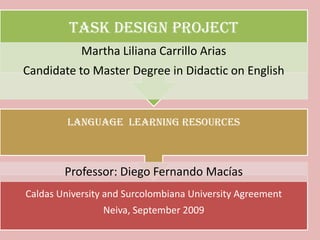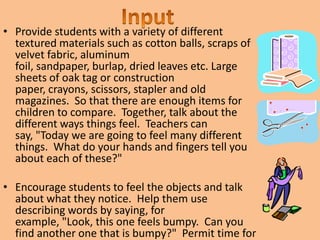Task Design Project
- 3. Objectives
- 4. LearnerâsProfileThepresenttaskproject is carried out with 26 first grade students from a private bilingual school in Neiva. According to their English proficiency they can be classified at a beginner level. They have a range age of 6. In their English program they have a content based science which is difficult for them because it implies to get science knowledge through English language.
- 5. introduce 5 senses using a videohttp://www.youtube.com/watch?v=hCVnaeoQNcw&feature=fvwINPUT
- 6. ACTIVITY ONEAfterseeingthe video, LABEL THE PICTURE WITH THE CORRESPONDING WORD
- 7. InputProvide students with a variety of different textured materials such as cotton balls, scraps of velvet fabric, aluminum foil, sandpaper, burlap, dried leaves etc. Large sheets of oak tag or construction paper, crayons, scissors, stapler and old magazines. So that there are enough items for children to compare. Together, talk about the different ways things feel. Teachers can say, "Today we are going to feel many different things. What do your hands and fingers tell you about each of these?" Encourage students to feel the objects and talk about what they notice. Help them use describing words by saying, for example, "Look, this one feels bumpy. Can you find another one that is bumpy?" Permit time for exploration.
- 8. After the textured pieces are sorted into piles, invite children to choose a pile and make a collage. Use each collage as a page in the book. When the book is completed look at the pages together and ask students to give you descriptive words and phrases that describe each page.Activity twoMake the Texture book
- 9. INPUTTeachers should know that taste buds are grouped on the front, sides and back of the tongue. Encourage students to use words like sweet, sour, salty and bitter to describe the foods. Provide them small samples of food. Tell them that they can taste them by putting a little on their tongues.
- 10. ActivitythreeEXPERIENCE CHARTPlace the words and pictures below according with the tasteCoffee, lemon, grape, candy, salt, ship potato, cake
- 11. INPUTTalk about how our noses help us smell things and provide students with cotton balls of liquid scents of onions, vanilla extract, vinegar, cinnamon rubbing alcohol, Perfume, lemon oil , peppermint extract.
- 12. students have to smell the cotton balls and decide in what recipient (that were previous labeled ) they are going to leave it ACTIVITY FOURonionvanillacinnamonLemmonvinegar
- 13. Take the children on a nature walk. Have the children describe to each other what they see in their surroundings. Input
- 14. After the nature walk have the children cut from old magazines pictures of what they saw outside. Glue the pictures to half a piece of construction paperActivityFive
- 15. Teacher can help to develop a sense of hearing and listening by helping students listen to animals from a tape recorder. Input
- 16. Children have to cut pictures of animals they heard out of magazines and glue the pictures on paper. Then use a tape recorder to record sounds of those animals and encourage children to point to the appropriate picture as each sound is played.Activity six
- 18. Activity SevenTESTDirections: List three observations for each of the five senses. Try to remember what we did in each activity


















